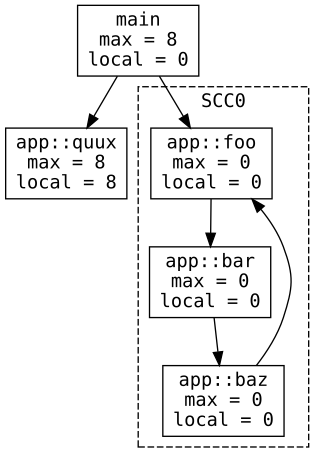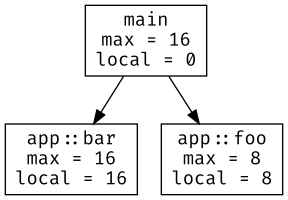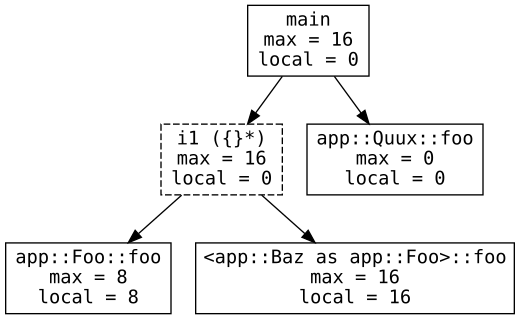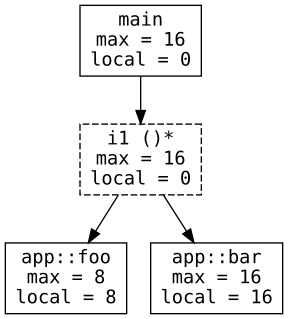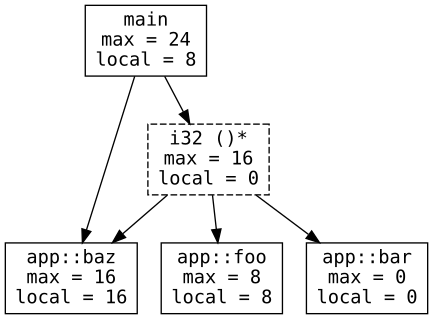17 releases
| 0.1.16 | Oct 28, 2024 |
|---|---|
| 0.1.15 | Feb 27, 2023 |
| 0.1.14 | Nov 24, 2022 |
| 0.1.11 | Jul 7, 2022 |
| 0.1.0 | Dec 3, 2018 |
#114 in Command line utilities
45 downloads per month
285KB
3.5K
SLoC
cargo-call-stack
Static, whole program stack usage analyzer
Other examples: Embedded CoAP / IPv4 server (source) "Hello, world!"
HEADS UP: This tool relies on an experimental feature (-Z stack-sizes)
and implementation details of rustc (like symbol mangling) and could stop
working with a nightly toolchain at any time. You have been warned! Last tested nightly: 2023-11-13.
NOTE: This tool main use case are embedded (microcontroller) programs that lack, or have very
little, indirect function calls and recursion. This tool is of very limited use -- specially its
stack usage analysis -- on programs that link to the standard library as even the smallest program
that links to the standard library will contain a large number of indirect function calls (like
trait object dynamic dispatch specially in core::fmt) and potential recursion (specially in
panicking branches).
Features
-
The tool produces the full call graph of a program as a dot file.
-
A start point can be specified to analyze only the call graph that begins at that function.
-
Each node (function) in the call graph includes the local stack usage of the function, if available (see
-Z emit-stack-sizes). -
The maximum stack usage of each function is also computed, or at least a lower bound is provided. Maximum stack usage of a function here refers to the stack usage that includes the stack used by functions that the function may invoke.
-
The tool has imperfect support for calls through function pointers (
fn()) and dynamic dispatch (dyn Trait). You will get a call graph from programs that do indirect calls but it will likely be missing edges or contain incorrect edges. It's best to use this tool on programs that only do direct function calls.
Known limitations
- Dynamically linked binaries are not supported. As a portion of the call graph is injected at runtime by the dynamic linker is not possible to produce a complete call graph or compute an upper bound of the program's stack usage.
Installation
$ # NOTE always use the latest stable release
$ cargo +stable install cargo-call-stack
$ rustup +nightly component add rust-src
Example usage
NOTE this tool requires that your Cargo project is configured to use fat LTO when Cargo uses the release profile. This is not the default configuration (as of Rust 1.63) so you'll need to add this to your
Cargo.toml:
[profile.release]
# `lto = true` should also work
lto = 'fat'
The tool builds your program in release mode with LTO enabled, analyses it and
then prints a dot file to stdout. See cargo call-stack -h for a list of build
options (e.g. --features).
NOTE if you have not set a compilation target in e.g.
.cargo/config.tomlthen you'll need to pass the--targetflag tocargo-call-stackeven if you are not cross compiling
NOTE the analysis corresponds to the newly produced binary, which won't be the same as the binary produced by
cargo +nightly build --release
$ cargo +nightly call-stack --example app > cg.dot
warning: assuming that llvm_asm!("") does *not* use the stack
warning: assuming that llvm_asm!("") does *not* use the stack
Graphviz's dot can then be used to generate an image from this dot file.
$ dot -Tsvg cg.dot > cg.svg
Each node in this graph represents a function, which could be a free function,
an inherent method or a trait method. Each directed edge indicates a "calls"
relationship. For example, in the above graph Reset calls both main and
DefaultPreInit.
Each node also contains its local stack usage in bytes and its max-imum
stack usage, also in bytes. The maximum stack usage includes the stack usage of
all the other functions that the function could invoke.
This is the no_std program used to generate the call graph shown above.
#![feature(llvm_asm)]
#![no_main]
#![no_std]
extern crate panic_halt;
use core::ptr;
use cortex_m_rt::{entry, exception};
#[entry]
fn main() -> ! {
foo();
bar();
loop {}
}
#[inline(never)]
fn foo() {
// spill variables onto the stack
unsafe { llvm_asm!("" : : "r"(0) "r"(1) "r"(2) "r"(3) "r"(4) "r"(5)) }
}
#[inline(never)]
fn bar() {
unsafe { llvm_asm!("" : : "r"(0) "r"(1) "r"(2) "r"(3) "r"(4) "r"(5) "r"(6) "r"(7)) }
}
#[exception]
fn SysTick() {
bar();
}
#[inline(never)]
fn baz() {
let x = 0;
unsafe {
// force `x` to be on the stack
ptr::read_volatile(&&x);
}
}
In the previous example the call graph contained disconnected subgraphs. The reason for that is exceptions (also known as interrupts).
SysTick, for example, is an exception handler that can preempt any function called fromReset. This exception handler is never called from software but can be invoked by the hardware at any time. These exception handlers can appear as the roots of disconnected subgraphs.
Start point
In some cases you may be interested in the maximum stack usage of a particular function. The tool lets you specify a start point which will be used to filter the call graph to only include nodes reachable from that function.
If we invoke the tool on the previous program but select main as the start
point we get this call graph:
$ cargo +nightly call-stack --example app main > cg.dot
warning: assuming that llvm_asm!("") does *not* use the stack
warning: assuming that llvm_asm!("") does *not* use the stack
Notice that SysTick and baz don't appear in this call graph since they are
not reachable from main.
Cycles
The tool can, in some cases, compute the maximum stack usage of programs that involve recursion. Recursion appears as cycles in the call graph. Consider the following example:
#![feature(llvm_asm)]
#![no_main]
#![no_std]
extern crate panic_halt;
use core::sync::atomic::{AtomicBool, Ordering};
use cortex_m_rt::{entry, exception};
static X: AtomicBool = AtomicBool::new(true);
#[inline(never)]
#[entry]
fn main() -> ! {
foo();
quux();
loop {}
}
// these three functions form a cycle that breaks when `SysTick` runs
#[inline(never)]
fn foo() {
if X.load(Ordering::Relaxed) {
bar()
}
}
#[inline(never)]
fn bar() {
if X.load(Ordering::Relaxed) {
baz()
}
}
#[inline(never)]
fn baz() {
if X.load(Ordering::Relaxed) {
foo()
}
}
#[inline(never)]
fn quux() {
// spill variables onto the stack
unsafe { llvm_asm!("" : : "r"(0) "r"(1) "r"(2) "r"(3) "r"(4) "r"(5)) }
}
#[exception]
fn SysTick() {
X.store(false, Ordering::Relaxed);
}
It produces the following call graph:
The functions foo, bar and baz use zero stack space thus the cycle formed
by them also uses zero stack space. In this particular case the maximum stack
usage of main can be computed.
For the curious this is the disassembly of the "cyclic" program:
08000400 <app::foo>:
8000400: f240 0000 movw r0, #0
8000404: f2c2 0000 movt r0, #8192 ; 0x2000
8000408: 7800 ldrb r0, [r0, #0]
800040a: 0600 lsls r0, r0, #24
800040c: bf18 it ne
800040e: f000 b801 bne.w 8000414 <app::bar>
8000412: 4770 bx lr
08000414 <app::bar>:
8000414: f240 0000 movw r0, #0
8000418: f2c2 0000 movt r0, #8192 ; 0x2000
800041c: 7800 ldrb r0, [r0, #0]
800041e: 0600 lsls r0, r0, #24
8000420: bf18 it ne
8000422: f000 b801 bne.w 8000428 <app::baz>
8000426: 4770 bx lr
08000428 <app::baz>:
8000428: f240 0000 movw r0, #0
800042c: f2c2 0000 movt r0, #8192 ; 0x2000
8000430: 7800 ldrb r0, [r0, #0]
8000432: 0600 lsls r0, r0, #24
8000434: bf18 it ne
8000436: f7ff bfe3 bne.w 8000400 <app::foo>
800043a: 4770 bx lr
0800043c <app::quux>:
800043c: b580 push {r7, lr}
800043e: f04f 0c00 mov.w ip, #0
8000442: f04f 0e01 mov.w lr, #1
8000446: 2202 movs r2, #2
8000448: 2303 movs r3, #3
800044a: 2004 movs r0, #4
800044c: 2105 movs r1, #5
800044e: bd80 pop {r7, pc}
08000450 <main>:
8000450: f7ff ffd6 bl 8000400 <app::foo>
8000454: f7ff fff2 bl 800043c <app::quux>
8000458: e7fe b.n 8000458 <main+0x8>
And yes, the estimated maximum stack usage is correct as shown in this debug session:
(gdb) b app::foo
(gdb) b app::bar
(gdb) b app::baz
(gdb) c
Continuing.
Breakpoint 3, main () at src/main.rs:16
16 foo();
(gdb) p $sp
$1 = (void *) 0x20005000
(gdb) c
Continuing.
halted: PC: 0x08000400
Breakpoint 4, app::foo () at src/main.rs:31
31 if X.load(Ordering::Relaxed) {
(gdb) p $sp
$2 = (void *) 0x20005000
(gdb) c
Continuing.
halted: PC: 0x0800040c
Breakpoint 5, app::bar () at src/main.rs:38
38 if X.load(Ordering::Relaxed) {
(gdb) p $sp
$3 = (void *) 0x20005000
(gdb) c
Continuing.
halted: PC: 0x08000420
Breakpoint 6, app::baz () at src/main.rs:45
45 if X.load(Ordering::Relaxed) {
(gdb) p $sp
$4 = (void *) 0x20005000
(gdb) c
Continuing.
halted: PC: 0x08000434
Breakpoint 4, app::foo () at src/main.rs:31
31 if X.load(Ordering::Relaxed) {
(gdb) p $sp
$5 = (void *) 0x20005000
Trait object dispatch
NOTE as of ~nightly-2022-09-20 there's no distinction between function pointers and trait objects at the llvm-ir so the analysis can insert an edge from a dynamic dispatch call site (caller) to a regular function (callee)
In some cases the tool can produce correct call graphs for programs that use trait objects -- more details about where and how it fails in the "Known limitations" section. Here's an example:
#![feature(llvm_asm)]
#![no_main]
#![no_std]
extern crate panic_halt;
use cortex_m_rt::{entry, exception};
use spin::Mutex; // spin = "0.5.0"
static TO: Mutex<&'static (dyn Foo + Sync)> = Mutex::new(&Bar);
#[entry]
#[inline(never)]
fn main() -> ! {
// trait object dispatch
(*TO.lock()).foo();
Quux.foo();
loop {}
}
trait Foo {
// default implementation of this method
fn foo(&self) -> bool {
// spill variables onto the stack
unsafe { llvm_asm!("" : : "r"(0) "r"(1) "r"(2) "r"(3) "r"(4) "r"(5)) }
false
}
}
struct Bar;
// uses the default method implementation
impl Foo for Bar {}
struct Baz;
impl Foo for Baz {
// overrides the default method
fn foo(&self) -> bool {
unsafe { llvm_asm!("" : : "r"(0) "r"(1) "r"(2) "r"(3) "r"(4) "r"(5) "r"(6) "r"(7)) }
true
}
}
struct Quux;
impl Quux {
// not a trait method!
#[inline(never)]
fn foo(&self) -> bool {
// NOTE(llvm_asm!) side effect to preserve function calls to this method
unsafe { llvm_asm!("NOP" : : : : "volatile") }
false
}
}
// this handler can change the trait object at any time
#[exception]
fn SysTick() {
*TO.lock() = &Baz;
}
The tool produces the following call graph:
Here i1 ({}*) denotes dynamic dispatch of a method with (Rust) signature
fn(&[mut] self) -> bool. The dynamic dispatch can invoke either Bar.foo,
which boils down to the default method implementation (app::Foo::foo in the
graph), or Baz.foo (<app::Baz as app::Foo>::foo in the graph). In this case
the tool does not a draw an edge between i1 ({}*) and Quux::foo, whose
signature is also fn(&self) -> bool, so the call graph is accurate.
If you are wondering why we use LLVM notation for the function signature of the
trait method: that's because the tool operates on LLVM-IR where there's no
bool primitive and most of Rust's type information has been erased.
Function pointers
NOTE as of ~nightly-2022-09-20 llvm discards type information associated to pointers and uses opaque pointers in llvm-ir so functions whose signature include references (and raw pointers) will include more callee edges that will never occur in practice.
In some cases the tool can produce correct call graphs for programs that
invoke functions via pointers (e.g. fn()). Here's an example:
#![feature(llvm_asm)]
#![no_main]
#![no_std]
extern crate panic_halt;
use core::sync::atomic::{AtomicPtr, Ordering};
use cortex_m_rt::{entry, exception};
static F: AtomicPtr<fn() -> bool> = AtomicPtr::new(foo as *mut _);
#[inline(never)]
#[entry]
fn main() -> ! {
if let Some(f) = unsafe { F.load(Ordering::Relaxed).as_ref() } {
// call via function pointer
f();
}
loop {}
}
fn foo() -> bool {
// spill variables onto the stack
unsafe { llvm_asm!("" : : "r"(0) "r"(1) "r"(2) "r"(3) "r"(4) "r"(5)) }
false
}
fn bar() -> bool {
unsafe { llvm_asm!("" : : "r"(0) "r"(1) "r"(2) "r"(3) "r"(4) "r"(5) "r"(6) "r"(7)) }
true
}
// this handler can change the function pointer at any time
#[exception]
fn SysTick() {
F.store(bar as *mut _, Ordering::Relaxed);
}
The tool produces the following call graph:
The node i1 ()* represents a call via function pointer -- the LLVM type i1 ()* is equivalent to Rust's fn() -> bool. This indirect call could invoke
foo or bar, the only functions with signature fn() -> bool.
Known limitations
Lossy type information
To reason about indirect function calls the tool uses the type information available in the LLVM-IR of the program. This information does not exactly match Rust's type information and leads to mislabeling of functions. For example, consider this program:
#![feature(llvm_asm)]
#![no_main]
#![no_std]
extern crate panic_halt;
use core::{
ptr,
sync::atomic::{AtomicPtr, Ordering},
};
use cortex_m_rt::{entry, exception};
static F: AtomicPtr<fn() -> u32> = AtomicPtr::new(foo as *mut _);
#[inline(never)]
#[entry]
fn main() -> ! {
if let Some(f) = unsafe { F.load(Ordering::Relaxed).as_ref() } {
// call via function pointer
f();
}
let x = baz();
unsafe {
// NOTE(volatile) used to preserve the return value of `baz`
ptr::read_volatile(&x);
}
loop {}
}
// this handler can change the function pointer at any time
#[exception]
fn SysTick() {
F.store(bar as *mut _, Ordering::Relaxed);
}
fn foo() -> u32 {
// spill variables onto the stack
unsafe { llvm_asm!("" : : "r"(0) "r"(1) "r"(2) "r"(3) "r"(4) "r"(5)) }
0
}
fn bar() -> u32 {
1
}
#[inline(never)]
fn baz() -> i32 {
unsafe { llvm_asm!("" : : "r"(0) "r"(1) "r"(2) "r"(3) "r"(4) "r"(5) "r"(6) "r"(7)) }
F.load(Ordering::Relaxed) as usize as i32
}
The tool produces the following call graph:
Note that the node that represents the indirect function call has type i32 ()*
(fn() -> i32), not u32 ()*. The reason is that there's no u32 type in
LLVM, there are only signed integers. This leads the tool to wrongly add an edge
between i32 ()* and baz. If the tool had Rust's type information then this
edge would have not been added.
Opaque pointers in llvm-ir
As of ~nightly-2022-09-20 llvm is discarding type information associated to pointers and instead
using opaque pointers (ptr) in llvm-ir.
This results in even greater loss of type information, for example:
- the signature of
fn f(x: &i32) -> boolbecomesfn(ptr) -> i1in llvm-ir - the signature of
impl Foo { fn f(&self) -> bool }also becomesfn(ptr) -> i1in llvm-ir
so the two are callee candidates for both a function pointer call with signature fn(&T) -> bool
and for dynamic dispatch of a method with signature fn(&self) -> bool
Miscellaneous
Inline assembly breaks LLVM's stack usage analysis.
LLVM does not consider inline assembly in its analysis and reports an incorrect number.
In this case, cargo-call-stack will use its own stack usage analysis based on machine code, which only supports the ARM Cortex-M architecture.
Hardware exceptions, like SysTick on Cortex-M devices, appear as disconnected nodes in the call graph.
At the moment, cargo-call-stack cannot compute the whole program maximum stack usage when exceptions are present.
The tool only supports ELF binaries because -Z emit-stack-sizes only supports the ELF format.
License
Licensed under either of
- Apache License, Version 2.0 (LICENSE-APACHE or http://www.apache.org/licenses/LICENSE-2.0)
- MIT license (LICENSE-MIT or http://opensource.org/licenses/MIT)
at your option.
Contribution
Unless you explicitly state otherwise, any contribution intentionally submitted for inclusion in the work by you, as defined in the Apache-2.0 license, shall be dual licensed as above, without any additional terms or conditions.
Dependencies
~7–16MB
~205K SLoC
